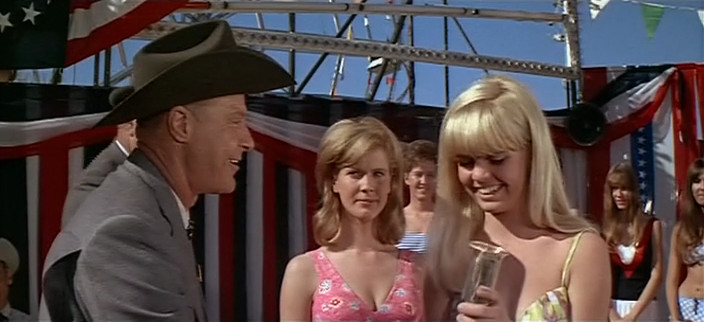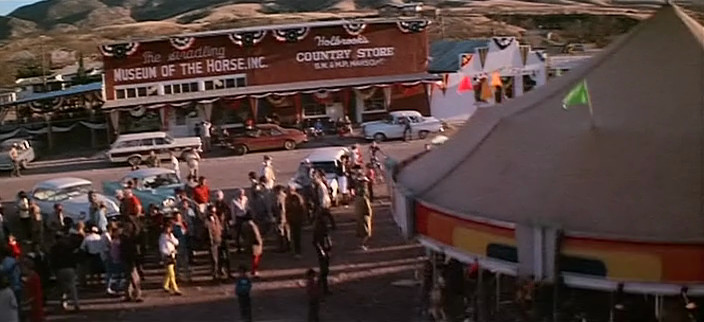Director: Daniel Haller
Writer: Charles B. Griffith
Stars: John Cassevetes, Beverly Adams, Mimsy Farmer and Maurice McEndree
 |
Index: Dry Heat Obscurities.
The landscape of American film changed in the late sixties in many ways and not only because American life changed too. Many of the things that the industry was used to and could safely rely on just weren’t the case any longer: the studios didn’t own theatres any more, television was eating heavily into ticket sales and the Production Code, which governed film ‘decency’, was increasingly being ignored. Society was in upheaval, with the civil rights movement and the counterculture, not to mention anti-Vietnam War protests. The studio heads, realising that their pictures were becoming increasingly irrelevant, eventually gave in, admitted that they were now completely out of touch and began to give large sums of money to whoever might possibly be in touch. This led to the New Hollywood of the early seventies, with the most fascinating set of movies seen in America since the pre-code era back in the early thirties. The studios didn’t get their mojo back until Jaws in 1975, arguably the first modern blockbuster.
If the big studios were akin to cruise liners, so couldn’t turn round quickly, indie filmmakers were speedboats and they could turn on a dime. Companies such as American International Pictures (A.I.P.) and filmmakers like Roger Corman, who shot many movies for them to distribute, could leap on every fad and have topical features in drive-ins in no time. To see where New Hollywood got their ideas (not to mention most of their key people), check out the indie films of the sixties. Biker flicks were just one sub-genre of exploitation but they were an important one in the late sixties and early seventies as people wanted to ‘turn on, tune in, drop out’. Many were carbon copies of their predecessors but others took the opportunity to explore themes that the studios weren’t willing to touch yet. Motorpsycho, from Russ Meyer, muses on PTSD; the first Billy Jack film, The Born Losers, adds prejudice against Native Americans; and, of course, Easy Rider became the definition of ‘a generation lost in space’ in 1969.
 |
This film is relatively loose and out of control, perhaps appropriately given the subject matter, but it explores an existential crisis, with our biker heroes attempting to escape the society that oppresses them to Hole-in-the-Wall, the legendary sanctuary of Butch Cassidy, that to them becomes an impossible dream. For all that the film romanticises the outlaw biker, clearly our hero, who only wants to live and let live outside the control of the Man, it also minimises him. As we start, Cody’s motorcycle club of two hundred has already dwindled down to twenty-six; by the time the key moment arrives, during the finalé, it decreases to one. Nobody else cares any more; they’re having too much fun indulging in stereotypical anti-social delinquent biker behaviour. In other words, we should approve of the outlaw biker and his wild west sense of honour and justice, but most of his riding buddies are just thugs and lowlifes whose degeneracies really do warrant the full attention of the law. It’s an interesting mixed message for 1967.
I’m watching because Devil’s Angels was mostly shot in Arizona, but that isn’t Arizona as we begin, not least because we don’t have a Pacific Ocean (until the big one hits the San Andreas). The aircraft boneyard scene may have been shot at Davis-Monthan Air Force Base in Tucson, but there just isn’t enough to make sure of that identification. Certainly the scenes that follow have been identified as San Pedro, CA, where Corman shot The Wild Angels a year earlier: Cabrillo Beach, Point Fermin and Gaffey Street. It seems like all the time the Skulls Motorcycle Club spends in California is focused on leaving, though. There’s nothing there any more, especially after Gage crashes his bike into a broken down car on the way to the clubhouse, leaving a man dead at the scene and a cop witness to his hit and run. Cody has his club tear down Gage’s recognisable bike into parts, pack up their inevitable collection of beer, pot and Nazi memorabilia, and peel out of there. He wants to find Hole-in-the-Wall, where they can all live in peace.
 |
What’s worst though, is that everything seems ruthlessly improvised. That approach can work wonders and, certainly, some of the most famous moments in film history were actually improvised, but all the hippie dippie dialogue here seems like the product of a copious quantity of marijuana. Surely at least some of the actors were stoned when they delivered it; perhaps even Chuck Griffith was stoned when he wrote the script. The only coherent things in this whole section are the decisions to leave the state and break out Skulls member Funky from the Lenning City Jail before they do. The latter is a good thing because Funky is a real character but most of his fellow Skulls are non-entities. When one can be distinguished from another, like with Robot, it’s because he hasn’t got a pair of brain cells to rub together and he’s used only for cheap comedic effect. Funky’s girl is a joy too, but the film does a lousy job at telling us names, so I can only assume that she’s Karen, played by Mitzi Hoag. This is early for her but later photos match up.
 |
It takes almost half an hour for the film to get where it needed to go, which is Brookville in the movie and Patagonia, AZ in reality. It’s your typical small town and they arrive during the 27th annual town picnic, which means a fairground, a beauty contest and a host of other things that bored bikers are quite happy to mess with. Initially, they just sit down in the bleachers to watch the girls in bikinis up on stage. However, as soon as sides are set up by the officials panicking about what these interlopers might do to the town, we’re thrown onto the side of the bikers in an odd way: Royce, the town’s mayor, awards first prize in the beauty contest to gormless Clara Hays over the cute new girl in town, Marianne Fielding, and we join the bikers in vocal disagreement. Marianne is an important character in the movie to come as she hangs around the bikes long enough to get picked up by another annoyingly unidentified character whom I presume is Roy, played by Kipp Whitman. younger brother of Stuart Whitman.
 |
The problem is that, even if we’re surely never going to find ourselves on Mayor Royce’s side and we aren’t given a chance to get to know the people of Brookville, we can’t really pledge our allegiance to the bikers either. Cody is a complex soul, the only one of the bunch, but even he’s a wildcard. What drove a wedge between me and the Skulls started with their penchant for crap beer and escalated through their bizarre habit of not actually drinking it. So much Coors is wasted here by spraying it at other folk, pouring it over other folk or just throwing it at other folk that I began to wonder if Smokey and the Bandit was a sequel to this film, made to restock the west with Coors after the Skulls abused the entire previous stock of two states; then I remembered that they hauled it east over the Mississippi, where it couldn’t be sold legally because of its lack of preservatives. Given that these bikers behave quite well compared to previous examples of the genre, not least The Wild Angels, the film can easily be seen as underwhelming.
 |
However, there are two obvious landmarks to identify Brookville as Patagonia, even though neither is there any more. The first is the Stradling Museum of the Horse Inc., located directly opposite the fairground, from which we see it often, including from the top of the ferris wheel. It was founded by Anne Stradling in 1960 to celebrate the horse throughout history; she and her husband also ran a ranch and a motel in town but, realising that none of these were sustainable, she eventually donated her collection, appraised at $10m, to the Hubbard Museum in Ruidoso, NM, in 1986. The other is the Big Steer, a bar that is featured prominently, both inside and out. This closed in 2001 and was remembered shortly afterwards by Paul ‘Sonny’ Showalter, a Patagonia Marshal’s deputy for 27 years, as ‘a fighting bar’. I wonder if it was a fighting bar in 1967 when the Skulls invaded or if that reputation came later. It’s sadly amusing to realise that we see it fictionally here as it apparently really was.
 |
The most memorable moments aren’t always the ones that should stand out, though. I got stuck on the fact that Coors in 1967 was apparently bought in soup-style cans on cardboard trays. Times have certainly changed. The music underlines that too, with a lot of pschedelic pop and surf music that doesn’t seem to fit today with hard rockin’ bikers in leathers. The theme tune is by Jerry and the Portraits, a band who don’t seem to have recorded anything else, while the rest of the score is by the Arrows, the backing band of Davie Allan, who specialised in soundtracks and recorded many for Corman’s biker flicks; his most successful song, Blues Theme, from The Wild Angels, was one of the first that Eddie van Halen learned to play. Some of the quirkier moments revolve around one of the Skull ladies, whose name I missed, if it was ever announced. She really wants to get pregnant but hasn’t decided yet on who the father should be; she eventually figures it out on a ouija board on the beach, while everyone else is partying.
 |
I can’t quite say that for all the cast though. John Cassavetes certainly did better work elsewhere and not just on screen; his three Oscar nominations were as an actor, a scriptwriter and a director respectively. He’s easily the best actor in the film as Cody but it’s hardly his best role. Cody’s girl, Lynn, is played by Beverly Adams, best known either for her role in How to Stuff a Wild Bikini or for marrying her hairdresser on Torture Garden, the film she made after this; that hairdresser was Vidal Sassoon. Honestly, I was more impressed by Mimsy Farmer, who makes Marianne a believable picture of almost innocence. Farmer had a highly unusual career, mostly in Italy; giallos like Four Flies on Grey Velvet and The Perfume of the Lady in Black; Lucio Fulci’s The Black Cat; and the war movie Code Name: Wild Geese. I liked Mitzi Hoag too, as Funky’s girl, Karen, but I never quite bought into her being part of this scene. She’s quirky, so fits with Funky, but just too nice to be associated with the Skulls. You could take her home to meet the parents.
 |



1 comment:
Yes the airplanes are at DM, on Kolb road between Wilmington and Craycrift
Post a Comment